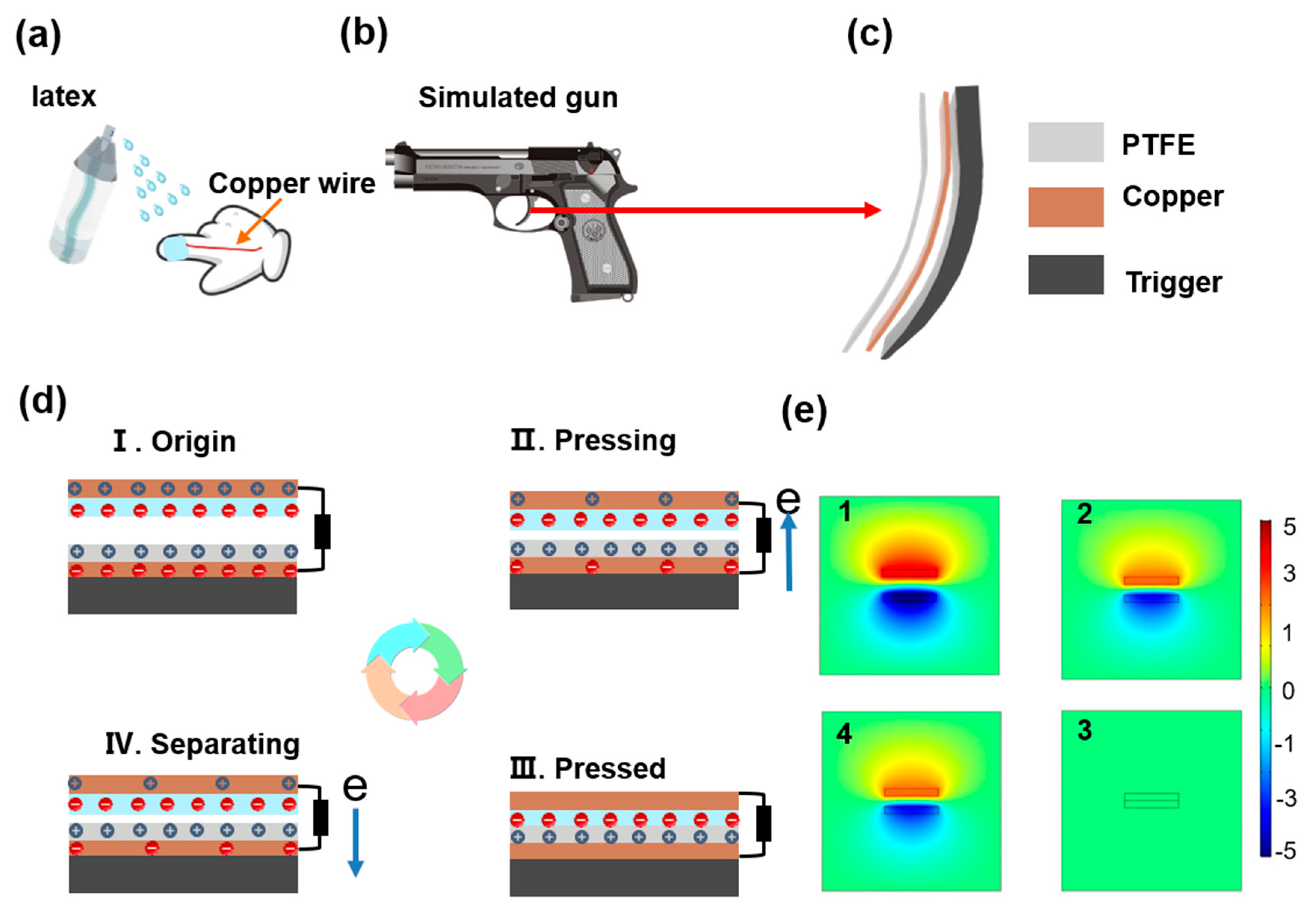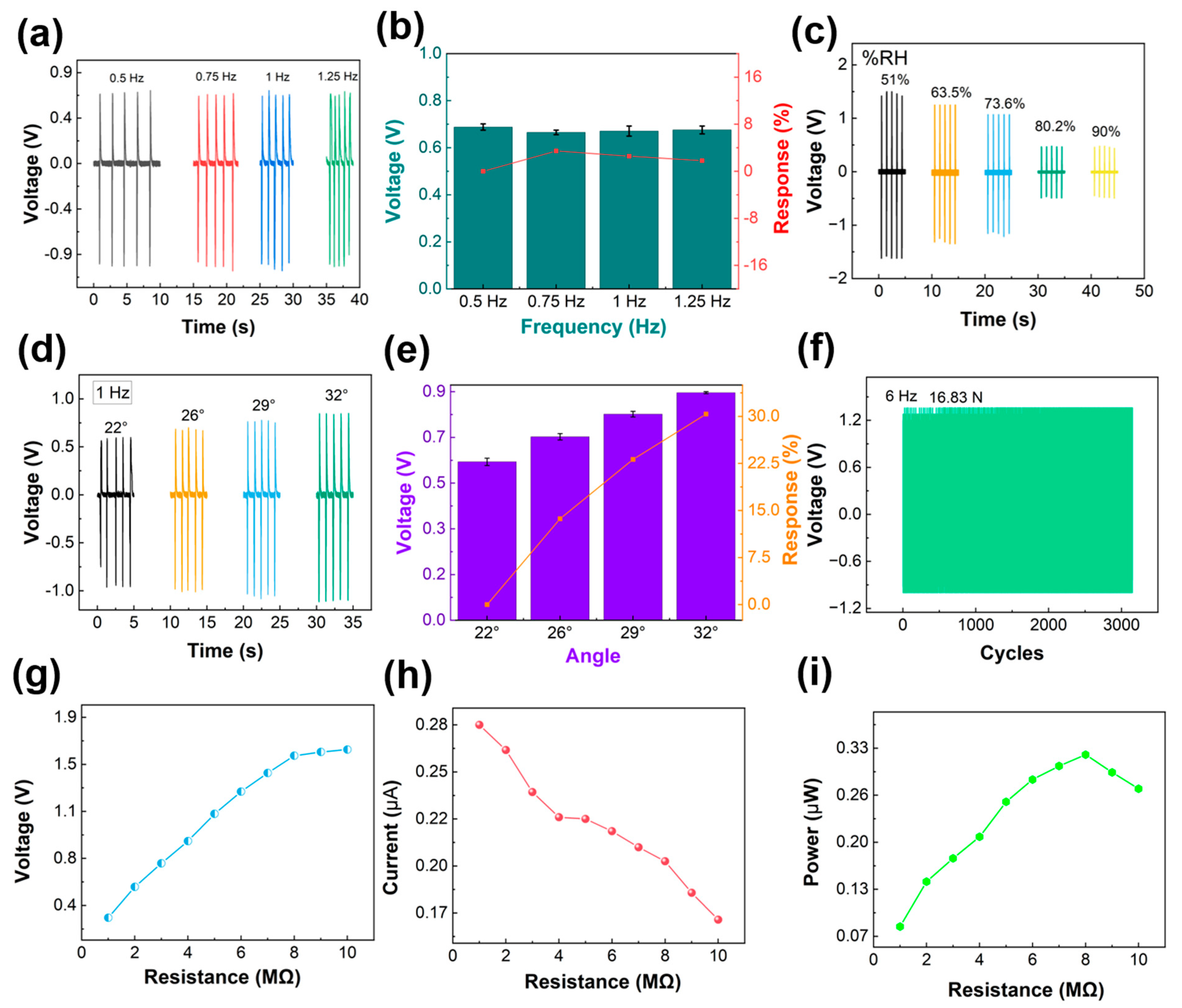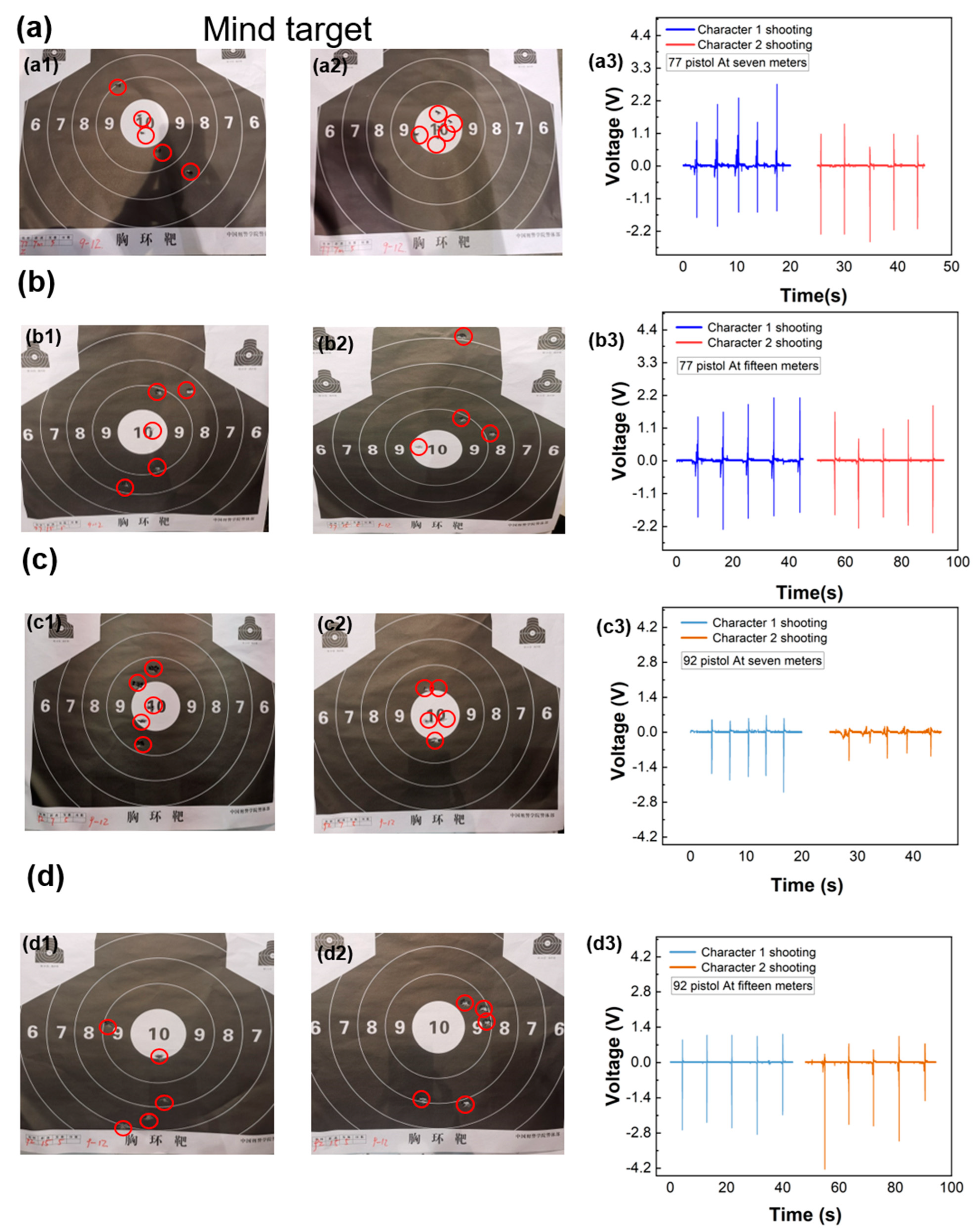A Self-Powered Triboelectric Nanogenerator Based on Intelligent Interactive System for Police Shooting Training Monitoring and Virtual Reality Interaction
Abstract
:1. Introduction
2. Materials and Methods
2.1. Materials
2.2. Methods
2.3. Test
3. Results
4. Conclusions
Supplementary Materials
Author Contributions
Funding
Institutional Review Board Statement
Informed Consent Statement
Data Availability Statement
Acknowledgments
Conflicts of Interest
References
- Wang, A.H.; Wang, P.S.; Miao, X.Q.; Li, X.M.; Ye, N.; Liu, Y. A review on non-terrestrial wireless technologies for Smart City Internet of Things. Int. J. Distrib. Sens. Netw. 2020, 16, 17. [Google Scholar] [CrossRef]
- Aydos, M.; Vural, Y.; Tekerek, A. Assessing risks and threats with layered approach to Internet of Things security. Meas. Control 2019, 52, 338–353. [Google Scholar] [CrossRef]
- Chen, S.Z.; Kang, S.L. A tutorial on 5G and the progress in China. Front. Inform. Technol. Elect. Eng. 2018, 19, 309–321. [Google Scholar] [CrossRef]
- Bin Zikria, Y.; Kim, S.W.; Afzal, M.K.; Wang, H.X.; Rehmani, M.H. 5G Mobile Services and Scenarios: Challenges and Solutions. Sustainability 2018, 10, 9. [Google Scholar] [CrossRef]
- Dong, M.J.; Fang, B.; Li, J.F.; Sun, F.C.; Liu, H.P. Wearable sensing devices for upper limbs: A systematic review. Proc. Inst. Mech. Eng. Part H J. Eng. Med. 2021, 235, 117–130. [Google Scholar] [CrossRef]
- Khalaf, A.S.; Alharthi, S.A.; Tran, S.; Dolgov, I.; Toups, Z.O. A Taxonomy for Selecting Wearable Input Devices for Mixed Reality. In Proceedings of the 14th ACM International Conference on Interactive Surfaces and Spaces (ISS), Daejeon, Korea, 10–13 November 2019; Association for Computing Machinery: New York, NY, USA, 2019; pp. 403–408. [Google Scholar]
- Han, L.; Li, Z.S.; Zhang, H.; Chen, D.Y. Wearable Observation Supporting System for Face Identification based on Wearable Camera. In Proceedings of the 3rd IEEE International Conference on Computer Science and Information Technology (ICCSIT), Chengdu, China, 9–11 July 2010; IEEE: Piscataway, NJ, USA, 2010; pp. 91–95. [Google Scholar]
- Yang, Q.; Chen, A.; Li, C.; Zou, G.S.; Li, H.F.; Zhi, C.Y. Categorizing wearable batteries: Unidirectional and omnidirectional deformable batteries. Matter 2021, 4, 3146–3160. [Google Scholar] [CrossRef]
- Zhao, T.M.; Fu, Y.M.; Sun, C.X.; Zhao, X.S.; Jiao, C.X.; Du, A.; Wang, Q.; Mao, Y.P.; Liu, B.D. Wearable biosensors for real-time sweat analysis and body motion capture based on stretchable fiber-based triboelectric nanogenerators. Biosens. Bioelectron. 2022, 205, 9. [Google Scholar] [CrossRef]
- Mao, Y.P.; Sun, F.X.; Zhu, Y.S.; Jia, C.J.; Zhao, T.M.; Huang, C.R.; Li, C.X.; Ba, N.; Che, T.T.; Chen, S. Nanogenerator-Based Wireless Intelligent Motion Correction System for Storing Mechanical Energy of Human Motion. Sustainability 2022, 14, 12. [Google Scholar] [CrossRef]
- Mao, Y.P.; Zhu, Y.S.; Zhao, T.M.; Jia, C.J.; Wang, X.; Wang, Q. Portable Mobile Gait Monitor System Based on Triboelectric Nanogenerator for Monitoring Gait and Powering Electronics. Energies 2021, 14, 12. [Google Scholar] [CrossRef]
- Sun, F.X.; Zhu, Y.S.; Jia, C.J.; Ouyang, B.W.; Zhao, T.M.; Li, C.X.; Ba, N.; Li, X.; Chen, S.; Che, T.T.; et al. A Flexible Lightweight Triboelectric Nanogenerator for Protector and Scoring System in Taekwondo Competition Monitoring. Electronics 2022, 11, 14. [Google Scholar] [CrossRef]
- Zhu, Y.S.; Sun, F.X.; Jia, C.J.; Zhao, T.M.; Mao, Y.P. A Stretchable and Self-Healing Hybrid Nano-Generator for Human Motion Monitoring. Nanomaterials 2022, 12, 15. [Google Scholar] [CrossRef] [PubMed]
- Lin, H.B.; Liu, Y.; Chen, S.L.; Xu, Q.H.; Wang, S.T.; Hu, T.; Pan, P.F.; Wang, Y.Z.; Zhang, Y.L.; Li, N.; et al. Seesaw structured triboelectric nanogenerator with enhanced output performance and its applications in self-powered motion sensing. Nano Energy 2019, 65, 9. [Google Scholar] [CrossRef]
- Xu, Q.H.; Fang, Y.S.; Jing, B.Q.S.; Hu, N.; Lin, K.; Pan, Y.F.; Xu, L.; Gao, H.Q.; Yuan, M.; Chu, L.; et al. A portable triboelectric spirometer for wireless pulmonary function monitoring. Biosens. Bioelectron. 2021, 187, 8. [Google Scholar] [CrossRef] [PubMed]
- Jobbagy, B.; Karchnak, J.; Simsik, D. Rehabilitation robotics and wearable sensors as trends of home rehabilitation. In Proceedings of the 15th International Carpathian Control Conference (ICCC), Velke Karlovice, Czech Republic, 28–30 May 2014; IEEE: Piscataway, NJ, USA, 2014; pp. 219–222. [Google Scholar]
- Lang, C.E.; Barth, J.; Holleran, C.L.; Konrad, J.D.; Bland, M.D. Implementation of Wearable Sensing Technology for Movement: Pushing Forward into the Routine Physical Rehabilitation Care Field. Sensors 2020, 20, 21. [Google Scholar] [CrossRef] [PubMed]
- Binkley, P.F.; Frontera, W.; Standaert, D.G.; Stein, J. Predicting the potential of wearable technology—Physicians share their vision of future clinical applications of wearable technology. IEEE Eng. Med. Biol. Mag. 2003, 22, 23–27. [Google Scholar] [CrossRef]
- Chen, H.H.; Chen, C.H.; Hoe, Z.Y.; Yin, Z.X. Ergonomic Consideration for Wearable Device Design in Frozen Shoulder Rehabilitation. In Proceedings of the International Conference on Physical Ergonomics and Human Factors, Orlando, FL, USA, 27–31 July 2016; Springer International Publishing: Cham, Switzerland, 2016; pp. 395–405. [Google Scholar]
- Herbert, R.; Jeong, J.W.; Yeo, W.H. Soft Material-Enabled Electronics for Medicine, Healthcare, and Human-Machine Interfaces. Materials 2020, 13, 4. [Google Scholar] [CrossRef]
- Shi, Q.F.; Zhang, Z.X.; Chen, T.; Lee, C.K. Minimalist and multi-functional human machine interface (HMI) using a flexible wearable triboelectric patch. Nano Energy 2019, 62, 355–366. [Google Scholar] [CrossRef]
- Herbert, R.; Kim, J.H.; Kim, Y.S.; Lee, H.M.; Yeo, W.H. Soft Material-Enabled, Flexible Hybrid Electronics for Medicine, Healthcare, and Human-Machine Interfaces. Materials 2018, 11, 33. [Google Scholar] [CrossRef]
- Yao, S.S.; Ren, P.; Song, R.Q.; Liu, Y.X.; Huang, Q.J.; Dong, J.Y.; O’Connor, B.T.; Zhu, Y. Nanomaterial-Enabled Flexible and Stretchable Sensing Systems: Processing, Integration, and Applications. Adv. Mater. 2020, 32, 31. [Google Scholar] [CrossRef]
- Dos Santos, D.M.P.; Neto, M.F.; Lemos, M.R.; da Silva, V.J.; Federal, W.A.D.; de Lucena, V.F. Wearable System for Early Identification of Parkinson’s Disease Symptoms Through the Evaluation of the Gait Training. In Proceedings of the 9th IEEE International Conference on Consumer Electronics (ICCE-Berlin), Berlin, Germany, 8–11 September 2019; IEEE: Piscataway, NJ, USA, 2019; pp. 51–56. [Google Scholar]
- Channa, A.; Popescu, N.; Ciobanu, V. Wearable Solutions for Patients with Parkinson’s Disease and Neurocognitive Disorder: A Systematic Review. Sensors 2020, 20, 20. [Google Scholar] [CrossRef]
- Ghoraani, B.; Galvin, J.E.; Jimenez-Shahed, J. Point of view: Wearable systems for at-home monitoring of motor complications in Parkinson’s disease should deliver clinically actionable information. Parkinsonism Relat. Disord. 2021, 84, 35–39. [Google Scholar] [CrossRef]
- Son, J.; Bae, G.Y.; Lee, S.; Lee, G.; Kim, S.W.; Kim, D.; Chung, S.; Cho, K. Cactus-Spine-Inspired Sweat-Collecting Patch for Fast and Continuous Monitoring of Sweat. Adv. Mater. 2021, 33, 9. [Google Scholar] [CrossRef] [PubMed]
- Glerum, L.E.; Egger, C.M.; Allen, S.W.; Haag, M. Analgesic effect of the transdermal fentanyl patch during and after feline ovariohysterectomy. Vet. Surg. 2001, 30, 351–358. [Google Scholar] [CrossRef] [PubMed]
- Maurya, A.; Nanjappa, S.H.; Honnavar, S.; Salwa, M.; Murthy, S.N. Rapidly Dissolving Microneedle Patches for Transdermal Iron Replenishment Therapy. J. Pharm. Sci. 2018, 107, 1642–1647. [Google Scholar] [CrossRef] [PubMed]
- Zhang, W.L.; Lu, Y.X.; Liu, T.; Zhao, J.M.; Liu, Y.H.; Fu, Q.; Mo, J.L.; Cai, C.C.; Nie, S.X. Spheres Multiple Physical Network-Based Triboelectric Materials for Self-Powered Contactless Sensing. Small 2022, 18, 9. [Google Scholar] [CrossRef] [PubMed]
- Cheng, T.H.; Gao, Q.; Wang, Z.L. The Current Development and Future Outlook of Triboelectric Nanogenerators: A Survey of Literature. Adv. Mater. Technol. 2019, 4, 7. [Google Scholar] [CrossRef]
- Yu, H.; He, X.; Ding, W.B.; Hu, Y.S.; Yang, D.C.; Lu, S.; Wu, C.S.; Zou, H.Y.; Liu, R.Y.; Lu, C.H.; et al. A Self-Powered Dynamic Displacement Monitoring System Based on Triboelectric Accelerometer. Adv. Energy Mater. 2017, 7, 8. [Google Scholar] [CrossRef]
- Zhang, J.; Xu, Q.; Li, H.; Zhang, S.; Hong, A.; Jiang, Y.; Hu, N.; Chen, G.; Fu, H.; Yuan, M.; et al. Self-Powered Electrodeposition System for Sub-10-nm Silver Nanoparticles with High-Efficiency Antibacterial Activity. J. Phys. Chem. Lett. 2022, 13, 6721–6730. [Google Scholar] [CrossRef]
- Palaniappan, V.; Masihi, S.; Zhang, X.; Emamian, S.; Bose, A.K.; Maddipatla, D.; Hajian, S.; Panahi, M.; Narakathu, B.B.; Bazuin, B.J.; et al. A Flexible Triboelectric Nanogenerator Fabricated Using Laser-Assisted Patterning Process. In Proceedings of the 18th IEEE Sensors Conference, Montreal, QC, Canada, 27–30 October 2019; IEEE: Piscataway, NJ, USA, 2019. [Google Scholar]
- Peng, Y.Y.; Xiao, S.G.; Yang, J.L.; Lin, J.; Yuan, W.; Gu, W.B.; Wu, X.Z.; Cui, Z. The elastic microstructures of inkjet printed polydimethylsiloxane as the patterned dielectric layer for pressure sensors. Appl. Phys. Lett. 2017, 110, 4. [Google Scholar] [CrossRef]
- Jing, T.T.; Xu, B.G.; Yang, Y.J. Liquid doping materials as micro-carrier of functional molecules for functionalization of triboelectric materials and flexible triboelectric nanogenerators for energy harvesting and gesture detection. Nano Energy 2020, 74, 11. [Google Scholar] [CrossRef]
- Shin, S.H.; Bae, Y.E.; Moon, H.K.; Kim, J.; Choi, S.H.; Kim, Y.; Yoon, H.J.; Lee, M.H.; Nah, J. Formation of Triboelectric Series via Atomic-Level Surface Functionalization for Triboelectric Energy Harvesting. ACS Nano 2017, 11, 6131–6138. [Google Scholar] [CrossRef] [PubMed]
- Wu, R.H.; Liu, S.; Lin, Z.F.; Zhu, S.H.; Ma, L.Y.; Wang, Z.L. Industrial Fabrication of 3D Braided Stretchable Hierarchical Interlocked Fancy-Yarn Triboelectric Nanogenerator for Self-Powered Smart Fitness System. Adv. Energy Mater. 2022, 12, 2201288. [Google Scholar] [CrossRef]
- Fu, X.P.; Bu, T.Z.; Xi, F.B.; Cheng, T.H.; Zhang, C.; Wang, Z.L. Embedded Triboelectric Active Sensors for Real-Time Pneumatic Monitoring. ACS Appl. Mater. Interfaces 2017, 9, 32352–32358. [Google Scholar] [CrossRef] [PubMed]
- Liu, B.H.; Libanori, A.; Zhou, Y.H.; Xiao, X.; Xie, G.Z.; Zhao, X.; Su, Y.J.; Wang, S.; Yuan, Z.; Duan, Z.H.; et al. Simultaneous Biomechanical and Biochemical Monitoring for Self-Powered Breath Analysis. ACS Appl. Mater. Interfaces 2022, 14, 7301–7310. [Google Scholar] [CrossRef] [PubMed]
- Hajra, S.; Panda, J.; Swain, J.; Kim, H.G.; Sahu, M.; Rana, M.K.; Samantaray, R.; Kim, H.J.; Sahu, R. Triazine skeletal covalent organic frameworks: A versatile highly positive surface potential triboelectric layer for energy harvesting and self-powered applications. Nano Energy 2022, 101, 11. [Google Scholar] [CrossRef]
- Hajra, S.; Sahu, M.; Sahu, R.; Padhan, A.M.; Alagarsamy, P.; Kim, H.G.; Lee, H.; Oh, S.; Yamauchi, Y.; Kim, H.J. Significant effect of synthesis methodologies of metal-organic frameworks upon the additively manufactured dual-mode triboelectric nanogenerator towards self-powered applications. Nano Energy 2022, 98, 12. [Google Scholar] [CrossRef]





Publisher’s Note: MDPI stays neutral with regard to jurisdictional claims in published maps and institutional affiliations. |
© 2022 by the authors. Licensee MDPI, Basel, Switzerland. This article is an open access article distributed under the terms and conditions of the Creative Commons Attribution (CC BY) license (https://creativecommons.org/licenses/by/4.0/).
Share and Cite
Li, S.; Jia, C.; Sun, F.; Zhu, Y. A Self-Powered Triboelectric Nanogenerator Based on Intelligent Interactive System for Police Shooting Training Monitoring and Virtual Reality Interaction. Materials 2022, 15, 6228. https://doi.org/10.3390/ma15186228
Li S, Jia C, Sun F, Zhu Y. A Self-Powered Triboelectric Nanogenerator Based on Intelligent Interactive System for Police Shooting Training Monitoring and Virtual Reality Interaction. Materials. 2022; 15(18):6228. https://doi.org/10.3390/ma15186228
Chicago/Turabian StyleLi, Songyang, Changjun Jia, Fengxin Sun, and Yongsheng Zhu. 2022. "A Self-Powered Triboelectric Nanogenerator Based on Intelligent Interactive System for Police Shooting Training Monitoring and Virtual Reality Interaction" Materials 15, no. 18: 6228. https://doi.org/10.3390/ma15186228





